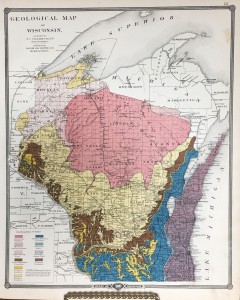Learning the Land: A new blog series
Posted on July 7, 2016 by Alex Shahbazi
Take a look around next time you’re out for a drive. Would you believe that what you’re seeing used to be a tropical sea? Or covered in ice sheets over 100 feet thick? That hill over there may be the remnants of an ancient volcano. The rocks beneath the road could be nearly 3 billion years old, around for two-thirds of Earth’s entire existence. Did you know that Wisconsin was once below the equator, or that the continents are actually giant slabs of rock floating on the partially molten mantle below?
Throughout this blog series, I will attempt to shed light onto the wonderful geological processes that shaped the Fox Cities region. From the Fox River, to Lake Winnebago, to High Cliff State Park, I will delve into why these places look the way they do, and what significance that has played in the human development of the area. What you see around you is only a small part of a greater narrative, and the earth is a complex place, always changing. We can use geology, the study of the earth, its history, and its various processes, to gain a fuller understanding of our surroundings and our past.
While Wisconsin’s landscape may not seem the most interesting at first glance, what with its lack of mountains, canyons, or volcanoes, there is still much to garner from learning about the geology of the region. The state has a complex geologic past, and it’s important to remember that human history is influenced much by the land. The Fox Cities exist as they are only because of the river flowing through them. The farmlands that cover Wisconsin rely on the fertile soil underneath. Both are a result of the glaciers that once covered much of the state.
When looking at any landscape with a geological eye, there is one key thing to think about: if it isn’t utterly flat, then something had to have taken place to make it look the way it does. A hill could be an old volcano, deposited sediments from a glacier, or leftovers from an ancient mountain-building event. A low area may be the result of a now-dry river eroding the land, or a massive glacier tearing the rock up. These processes are incredibly influential and powerful; rock is quite tough, an experiment you can conduct in your own backyard.
It’s important to keep in mind that geologic processes rarely happen over timescales we humans can understand. Yes, we can imagine a volcanic explosion ripping away a mountain or an earthquake tearing a crack in the ground, but these are uncommon. A river can carve canyons, wind can tear down mountains, and continents travel the world. These actions, though, take thousands to billions of years to reach full effect.
I hope by the end of this series, you will no longer simply look out your car window and see a hill with grass on it. Instead, I hope that you’ll wonder: how on Earth did it get there?
General











Leave a Comment